
One of the well-known DecisionPoint sentiment indicator charts is the "NAAIM Exposure Index". NAAIM stands for the National Association of Active Investment Managers. This professional group reports its exposure to US stocks on a weekly basis. The exposure index reflects the average exposure of NAAIM members. We saw extraordinarily high exposure readings in November, but in December they are pulling back their exposure from those extremes, likely in preparation for a market decline in January.

The DecisionPoint Alert Weekly Wrap presents an end-of-week assessment of the trend and condition of the Stock Market, the U.S. Dollar, Gold, Crude Oil, and Bonds. The DecisionPoint Alert daily report (Monday through Thursday) is abbreviated and gives updates on the Weekly Wrap assessments.
Watch the latest episode of DecisionPoint on StockCharts TV's YouTube channel here!
MAJOR MARKET INDEXES
Today: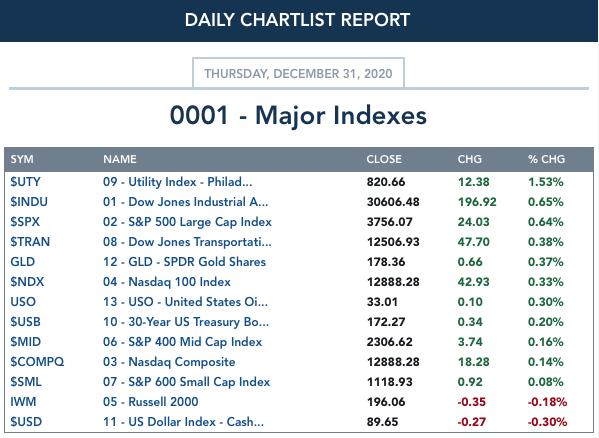
SECTORS
Each S&P 500 Index component stock is assigned to one, and only one, of 11 major sectors. This is a snapshot of the Intermediate-Term (Silver Cross) and Long-Term (Golden Cross) Trend Model signal status for those sectors.
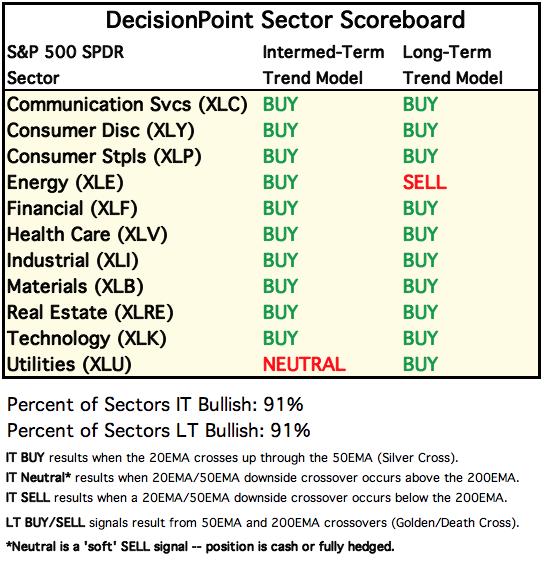
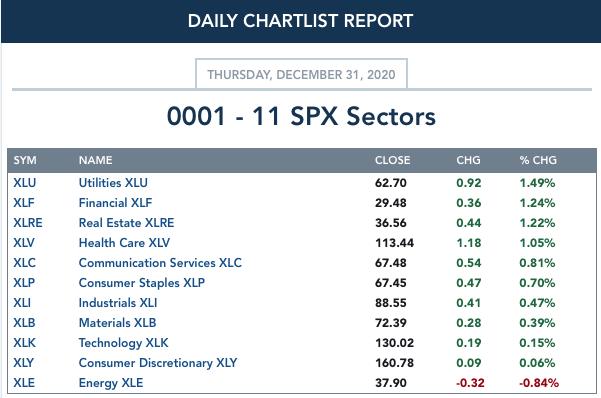
CLICK HERE for Carl's annotated Sector charts.
THE MARKET (S&P 500)
IT Trend Model: BUY as of 5/8/2020
LT Trend Model: BUY as of 6/8/2020
SPY Daily Chart: The bearish rising wedge pattern is technically intact, but as price travels further down the pattern toward the apex, the pattern begins to get "stale" and could resolve in either direction with very little price movement. We still favor the downside resolution given the PMO SELL signal and negative divergence with the OBV. We can now add an RSI that is getting overbought.
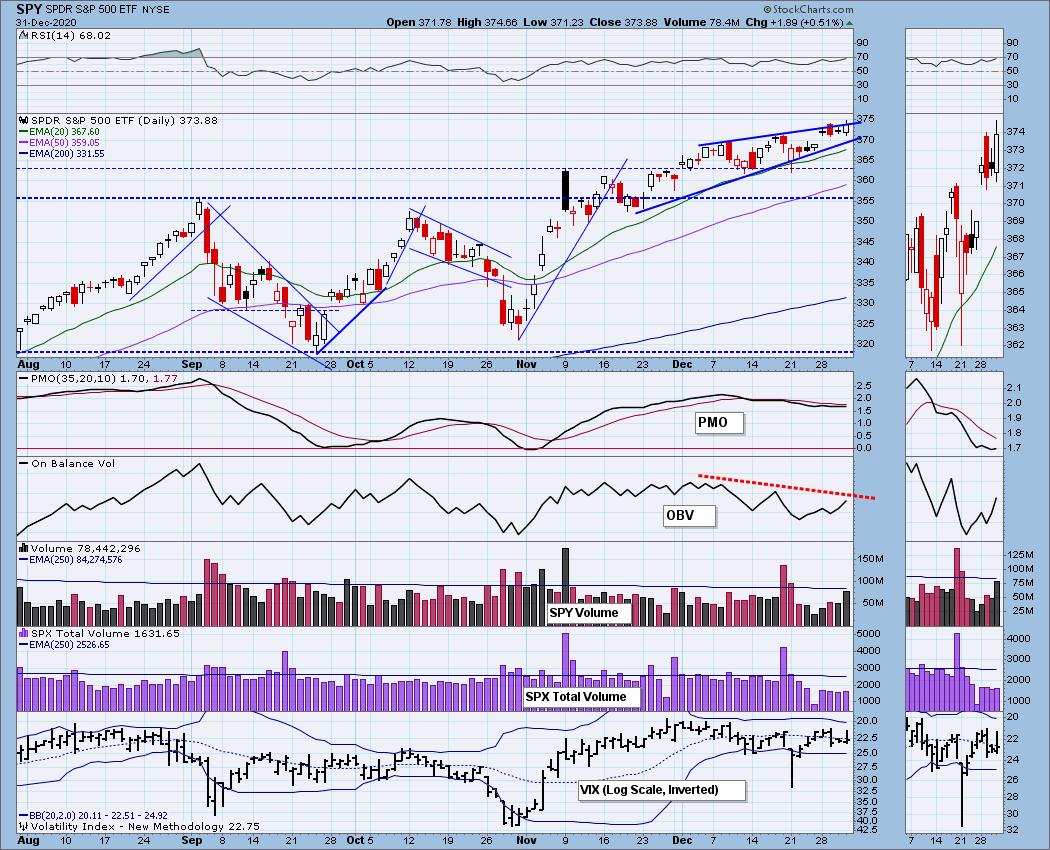
A reverse island is still visible. Notice we had an almost identical looking island in June. The Bollinger Band squeeze is on for the VIX. Typically a squeeze precedes price declines, pullbacks and corrections.
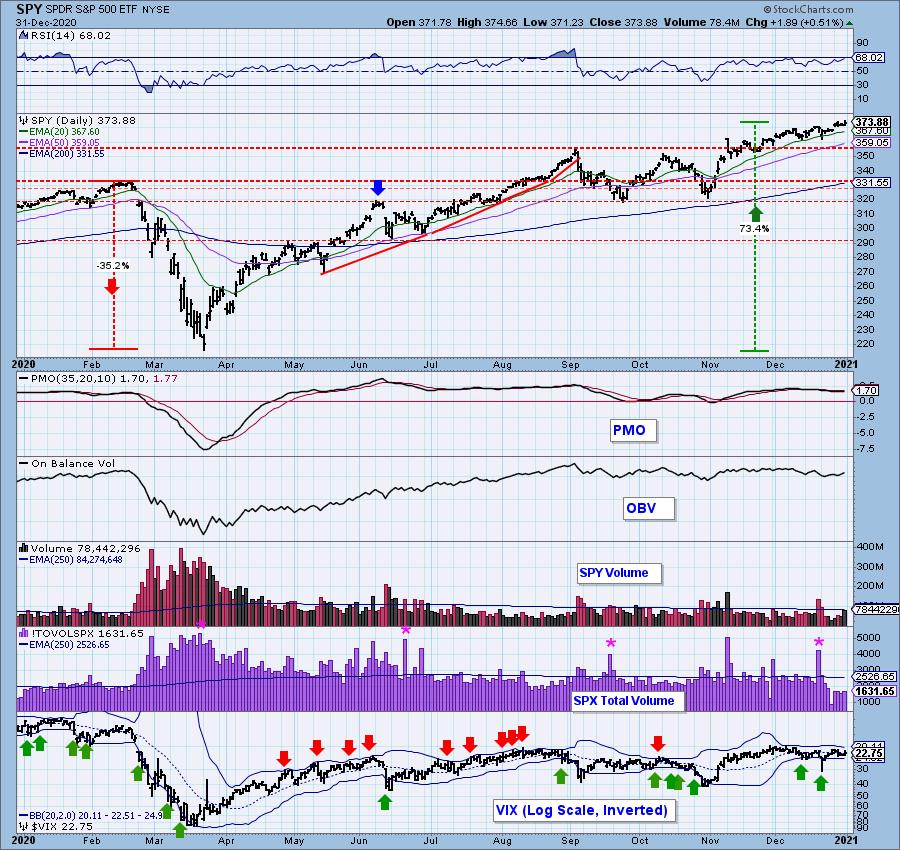
SPY Weekly Chart: Price has popped out above the already bearish megaphone pattern. The island is also visible on the weekly chart. The PMO is highly overbought.
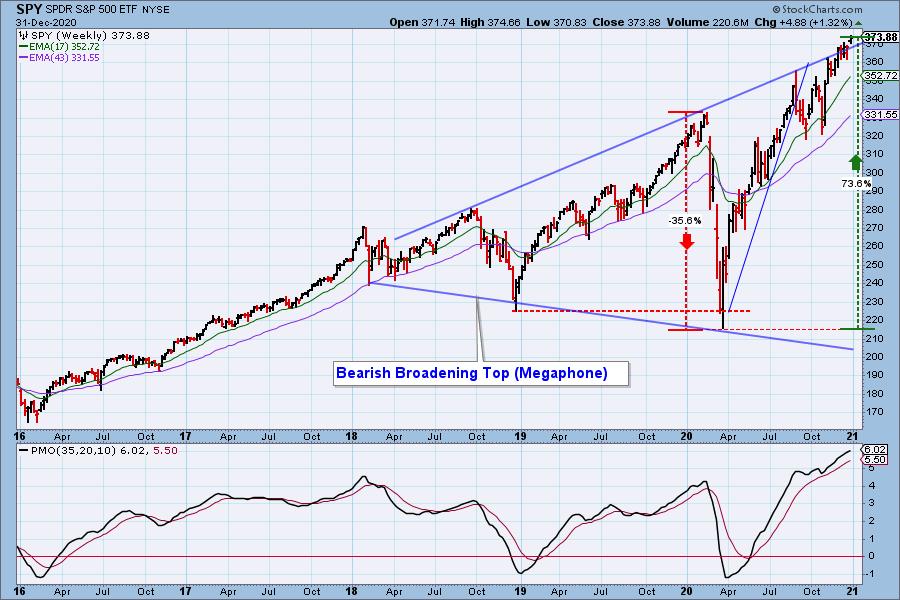
S&P 500 Monthly Chart: The PMO is on a crossover BUY signal in this timeframe and is rising nicely which is long-term bullish. It isn't nearly as overbought as the weekly PMO. However, the rising trend on the monthly chart is almost vertical and will be difficult to maintain.

Participation: The following chart uses different methodologies for objectively showing the depth and trend of participation for intermediate- and long-term time frames.
- The Silver Cross Index (SCI) shows the percentage of SPX stocks on IT Trend Model BUY signals (20-EMA > 50-EMA).
- The Golden Cross Index (GCI) shows the percentage of SPX stocks on LT Trend Model BUY signals (50-EMA > 200-EMA).
- The Bullish Percent Index (BPI) shows the percentage of SPX stocks on Point & Figure BUY signals.
The BPI had a positive crossover today, but overall it is trending lower and is has a negative divergence with price tops. The SCI continues lower out of overbought territory after a negative crossover its signal line. The GCI continues to rise despite being at overbought extremes.
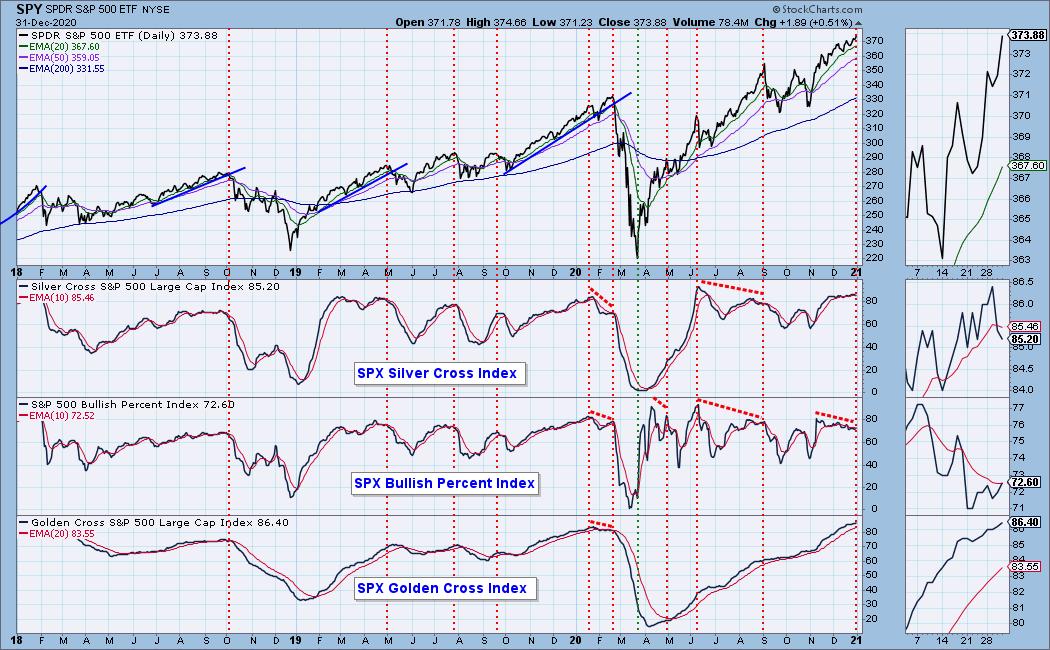
We did see a marked improvement of %Stocks > 20-EMA, but now it is moving into overbought territory. The intermediate term and long term readings of %Stocks > 50/200-EMAs are very overbought.
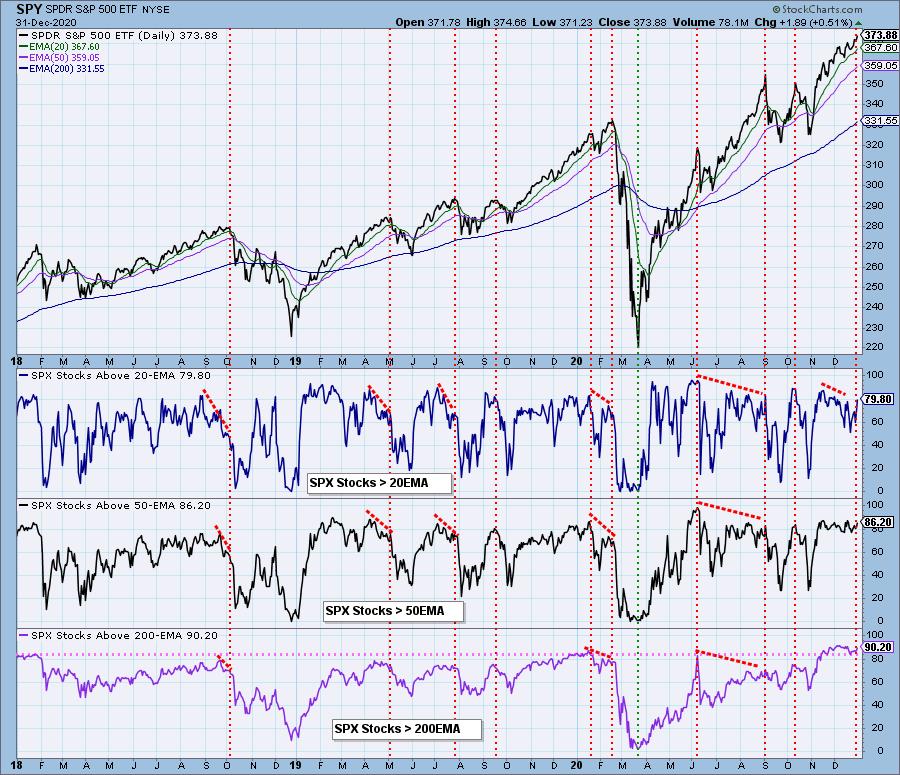
Climax Analysis: We saw an elevated reading on Net A-D, but no confirmation arrived via the Net A-D Volume or VIX. We could still consider this a possible buying exhaustion.

NYSE Up/Down and Down/Up volume ratios can be also be used as climax detectors. We use the 9:1 ratio suggested by the late Dr. Martin Zweig in his book, Winning on Wall Street. These climaxes happen less frequently than those on the chart above, and they can be used to clarify a particular event. We have an NYSE and S&P 500 version of the ratios, and normally they will only be published when there is a climax ratio.
There were no climaxes in either the NYSE or SPX Volume Ratios last week.
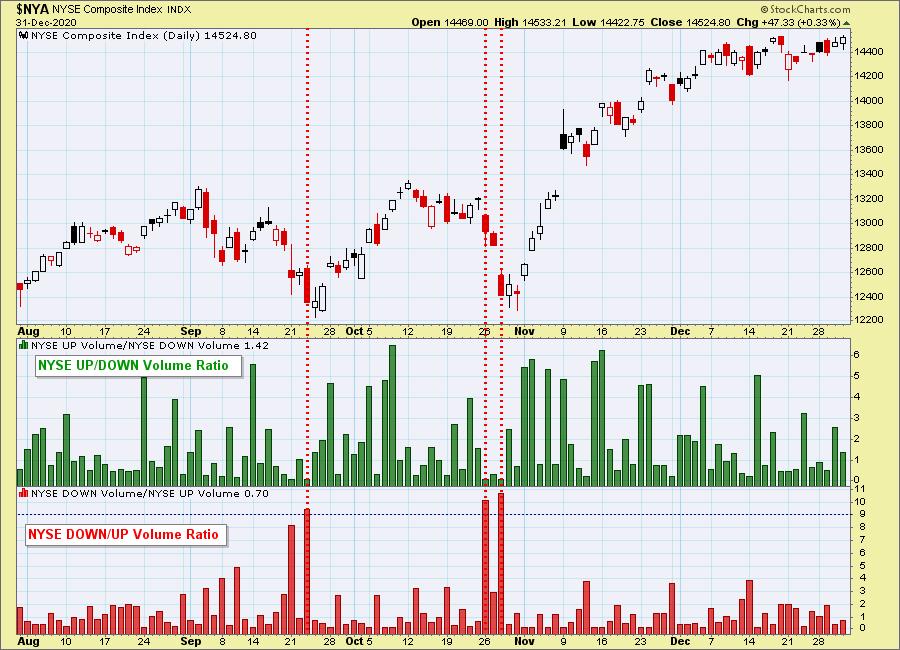
The S&P 500 version can get different results than the NYSE version because: (a) there are only 500 stocks versus a few thousand; and (b) those 500 stocks are all large-cap stocks that tend to move with more uniformity.
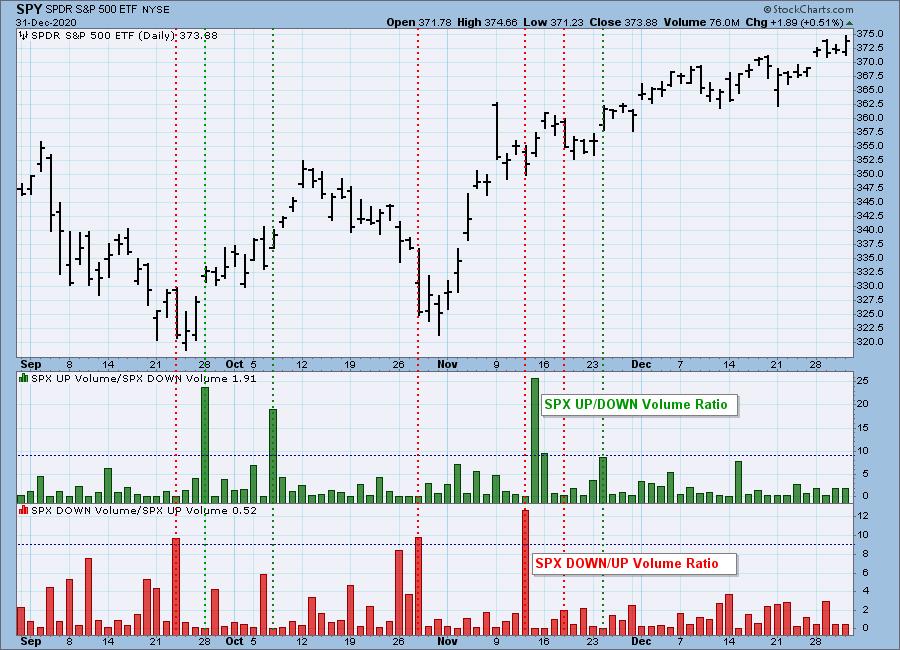
Short-Term Market Indicators: The short-term market trend is UP and the condition is SOMEWHAT OVERBOUGHT. The short-term market bias is BULLISH.
The STOs continue to rise suggesting more sideways movement or possibly higher prices. Close to half of the SPX members have rising momentum and that number is climbing. We want to see more participation in order to fuel higher prices in the short term.
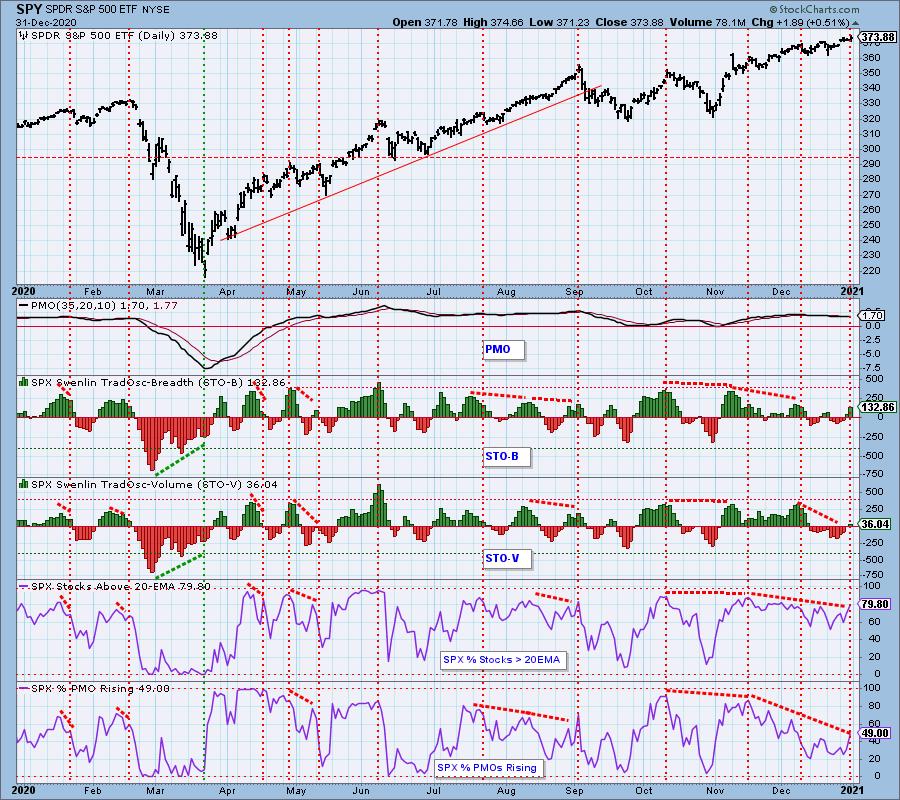
Intermediate-Term Market Indicators: The intermediate-term market trend is UP and the condition is OVERBOUGHT. The market bias is NEUTRAL.
The ITBM rose slightly today while the ITVM fell once again. The strong negative divergences are continue to be a problem.

CONCLUSION: Favorable seasonality prevailed as expected during the holidays. However, they are ending and it will be time to deal with the bearish negative divergences and highly overbought conditions. The VIX Bollinger Band squeeze in December suggests volatility ahead in January. NAAIM members are pulling back their exposure heading into January so it might be time to do the same.
Erin noted the following in yesterday's DP Alert:
"There's still a presidential transition to deal with and it will be interesting to see how the market reacts.
Another item to keep in mind is the distribution of stimulus which could put a bullish light on Financials as it did after the last round of stimulus and PPP were released.
Finally, there is the ever-present COVID complications as vaccines are rolled out and new strains are begin to pop up. Healthcare could be rather volatile in the coming month."
Have you subscribed the DecisionPoint Diamonds yet? DP does the work for you by providing handpicked stocks/ETFs from exclusive DP scans! Add it with a discount! Contact support@decisionpoint.com for more information!
INTEREST RATES
This chart is included so we can monitor rate inversions. In normal circumstances the longer money is borrowed the higher the interest rate that must be paid. When rates are inverted, the reverse is true.
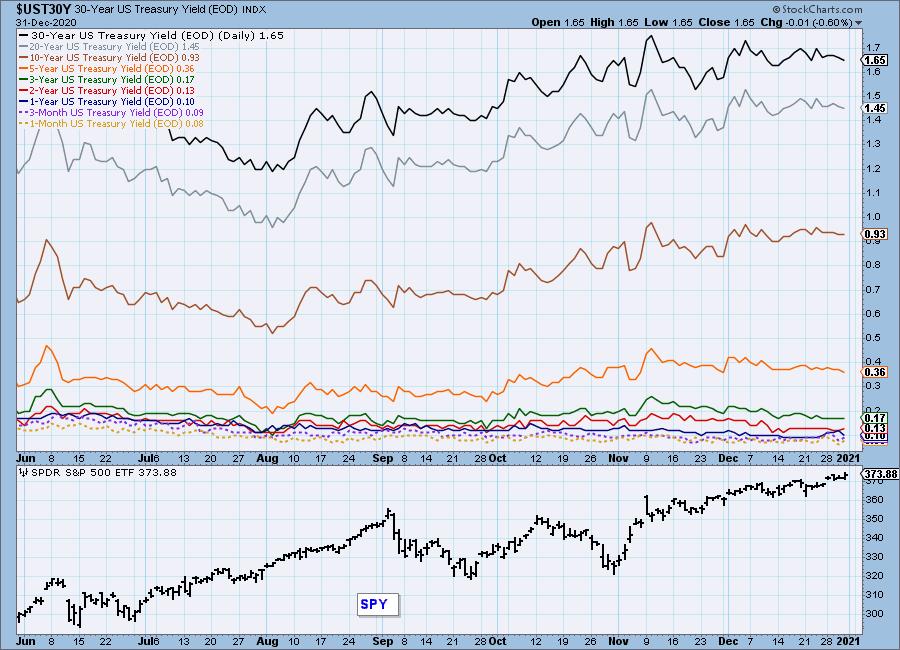
DOLLAR (UUP)
IT Trend Model: NEUTRAL as of 5/28/2020
LT Trend Model: SELL as of 7/10/2020
UUP Daily Chart: The Dollar rallied today but didn't come close to breaking out of its declining trend. The PMO is on a SELL signal, but overall it is flat. A flat PMO is indicative of a decline that is steady with no acceleration lower, we consider that neutral, not bullish or bearish. The RSI is negative but no longer oversold.
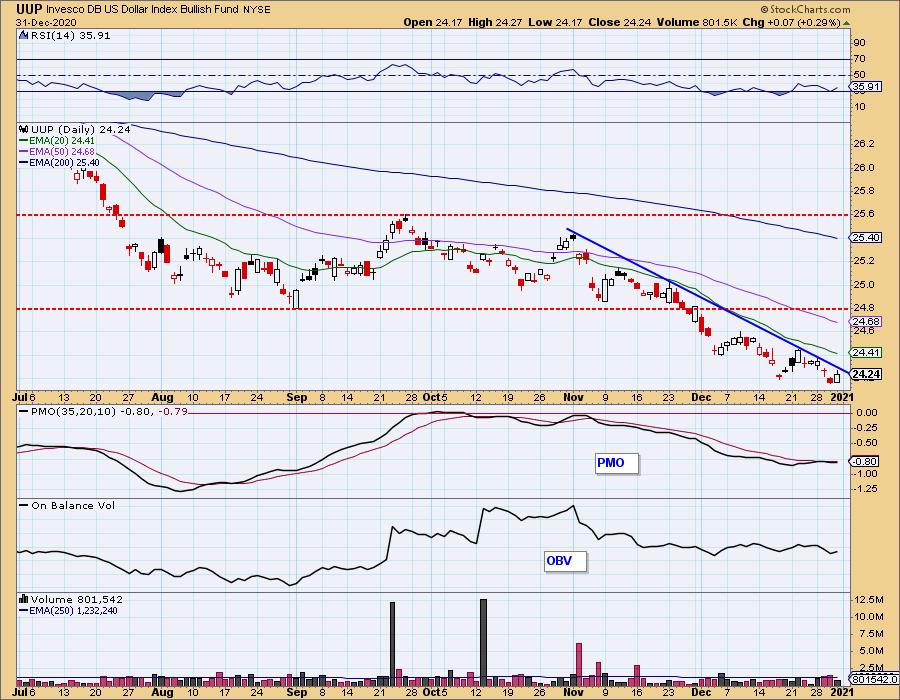
There is a bullish bias in the short term given the rising RSI and PMO that could give us a crossover BUY signal soon.
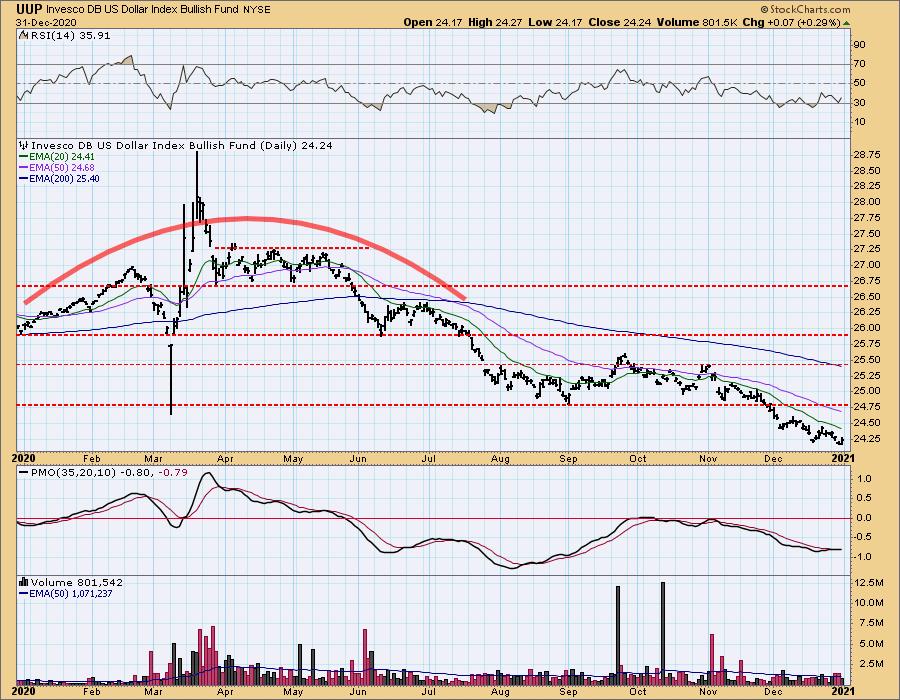
UUP Weekly Chart: However, the intermediate term and long term are not bullish for the Dollar. The weekly PMO top below the signal line is very bearish, but it has reached extremely oversold territory.
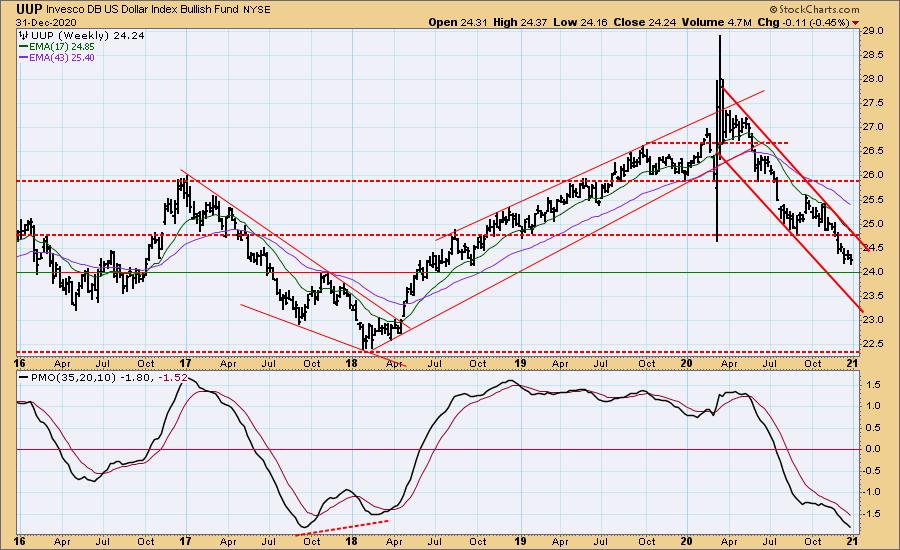
UUP Monthly Chart: The falling monthly PMO tells us to expect further decline in the long term.
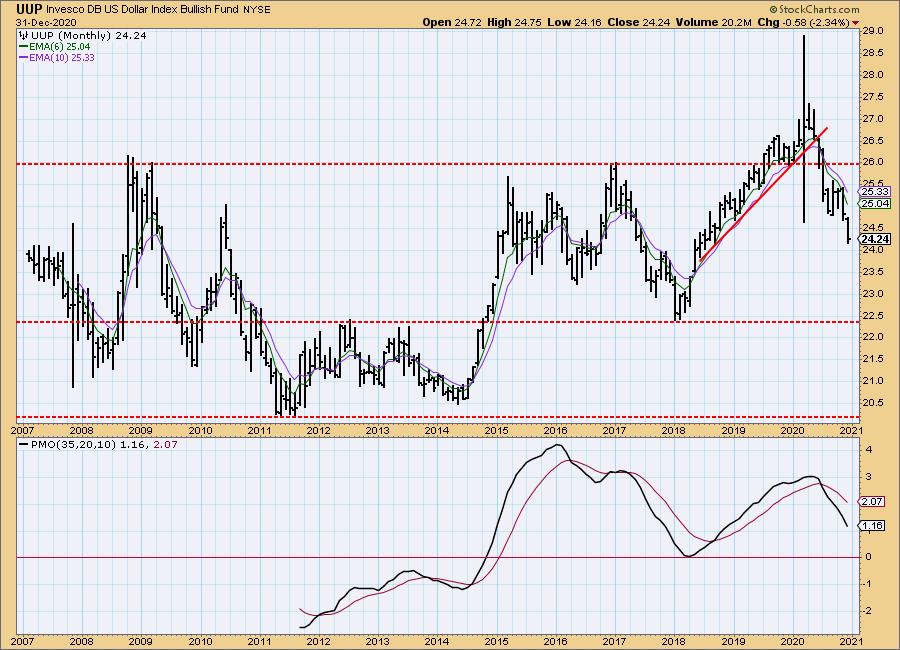
GOLD
IT Trend Model: NEUTRAL as of 10/14/2020
LT Trend Model: BUY as of 1/8/2019
GOLD Daily Chart (Comments from Carl's article on Wednesday): I frequently use the word "tortured" when discussing gold because so much of the time any progress it makes comes with great pain and suffering. In August GLD broke above the resistance line drawn across the 2011 price top. It was a decisive break, meaning that the breakout was likely to hold, and that the rally was likely to continue. But, no. Instead, typically, it broke down and began a corrective phase that may or may not have run its course.
A rising trend emerged from the November low, but unfortunately, it began retreating from the mid-November top, forming a bearish rising wedge. Since reaching the rising trend line, GLD has been hugging the line rather than moving back to the top of the wedge, so we should expect breakdown soon. If the potential of the current rally is to be fulfilled, GLD will need to find a bottom somewhere above the November low.

While I lead with the ETF candlestick chart, I like to follow the continuous contract futures chart, because, let's face it, we don't think of the price of gold as being whatever the ETF price is. The current rally still looks plausible with the PMO rising off a bull market oversold level. Sentiment is still solidly negative, which is bullish.
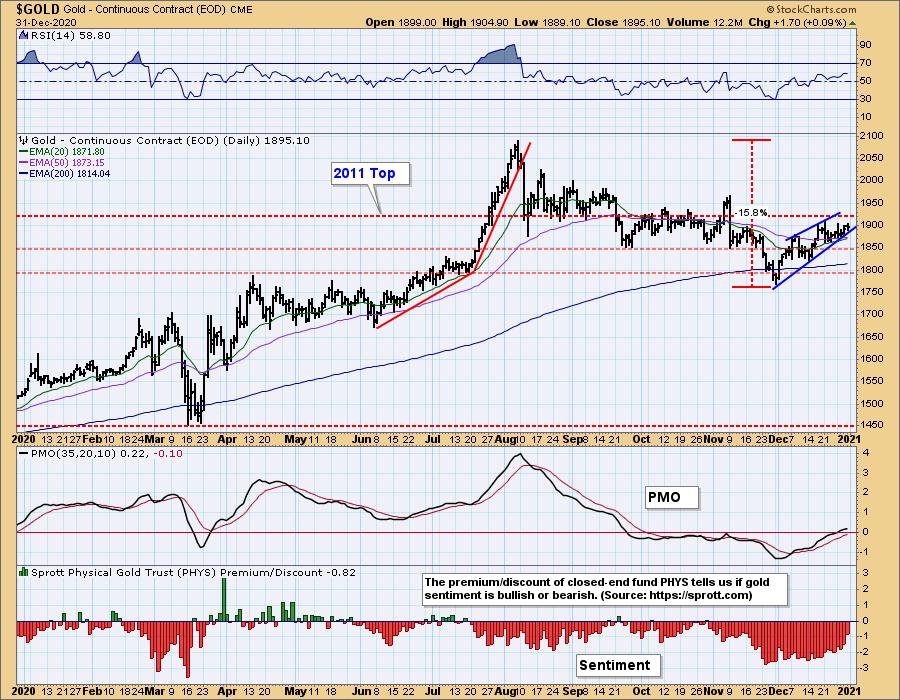
GOLD Weekly Chart: In the weekly time frame, the correction presents as a bullish falling flag formation, which has permitted the weekly PMO to correct down from extremely overbought levels to modestly overbought levels.
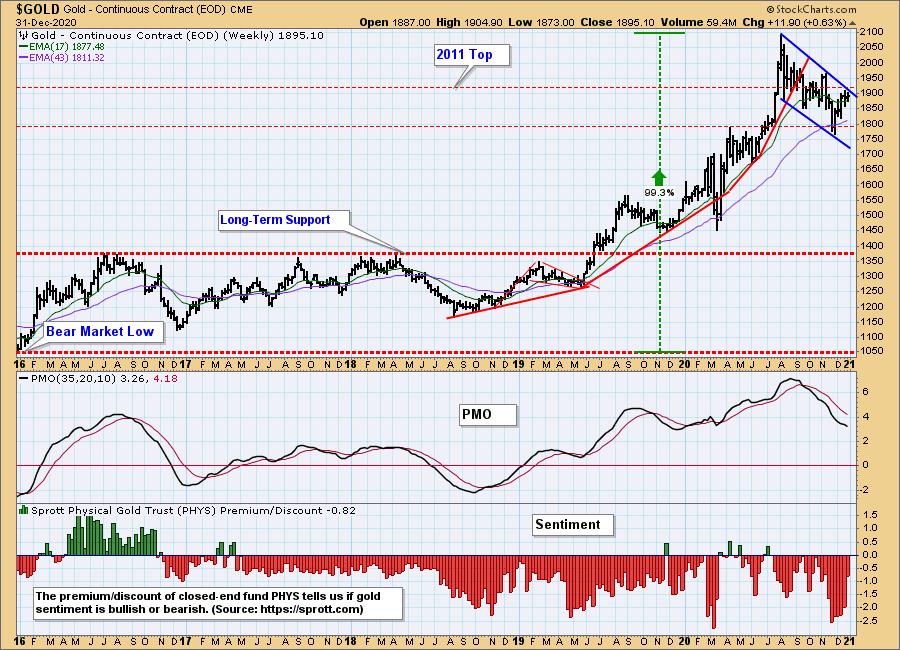
GOLD Monthly Chart: The monthly chart shows that gold has broken down from the parabolic advance off the 2016 low. There is potential for gold to return to the basing area between about 1000 and 1400, but that seems unlikely at this time.

GOLD MINERS Golden and Silver Cross Indexes: The Miners have created a nice short-term rising trend channel but strong overhead resistance is holding price back. The indicators have improved and are not particularly overbought and the PMO is rising. This could fuel a breakout from the longer-term declining trend channel.
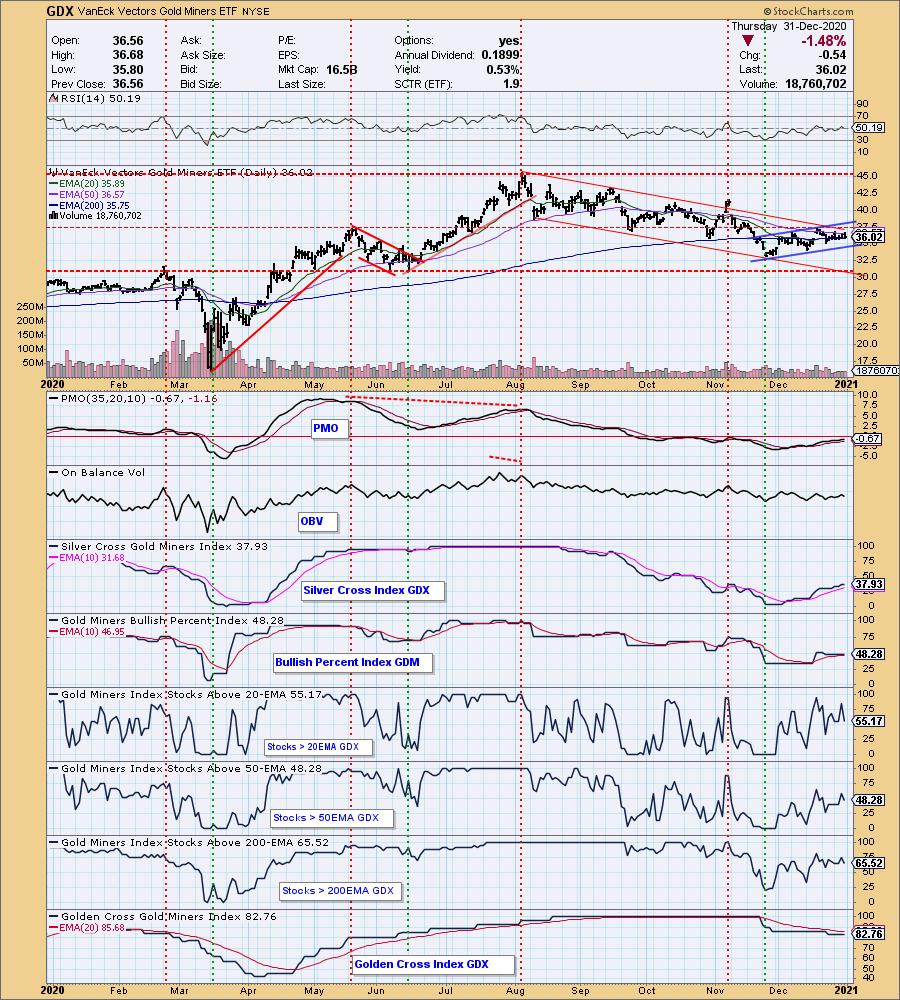
CRUDE OIL (USO)
IT Trend Model: BUY as of 11/23/2020
LT Trend Model: SELL as of 2/3/2020
USO Daily Chart: Oil is consolidating after the gap down a few weeks ago. The PMO is on a crossover SELL signal that occurred in very overbought territory.

Price is holding above the 20-EMA and the RSI is positive. Overall the short term bias is neutral.

USO/$WTIC Weekly Chart: The weekly PMO is rising out of negative territory and is not overbought. With price holding above the 17-week EMA the intermediate-term bias is bullish.
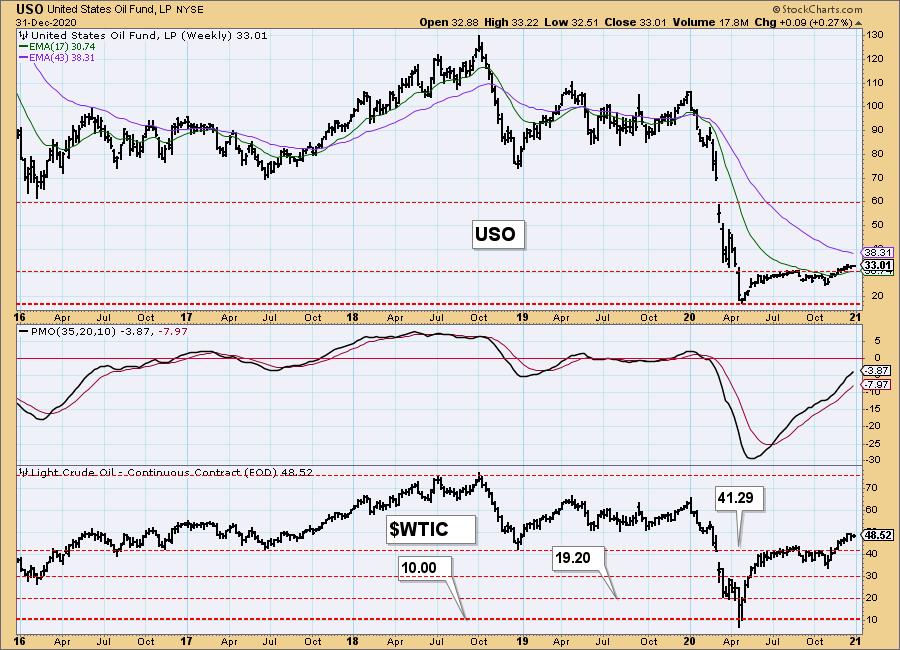
$WTIC Monthly Chart: The monthly PMO is also bullish as it rises strong above the zero line and is not overbought. However, we do see the declining trend that stunts upside potential.
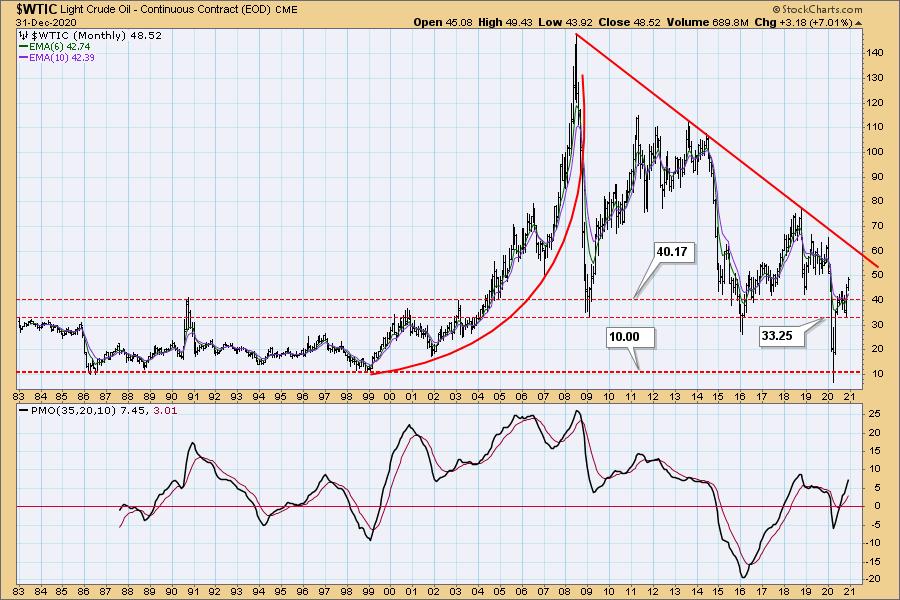
BONDS (TLT)
IT Trend Model: NEUTRAL as of 8/27/2020
LT Trend Model: BUY as of 1/2/2019
TLT Daily Chart: We've annotated a short-term symmetrical triangle. These are continuation patterns and would suggest resolution to the downside.
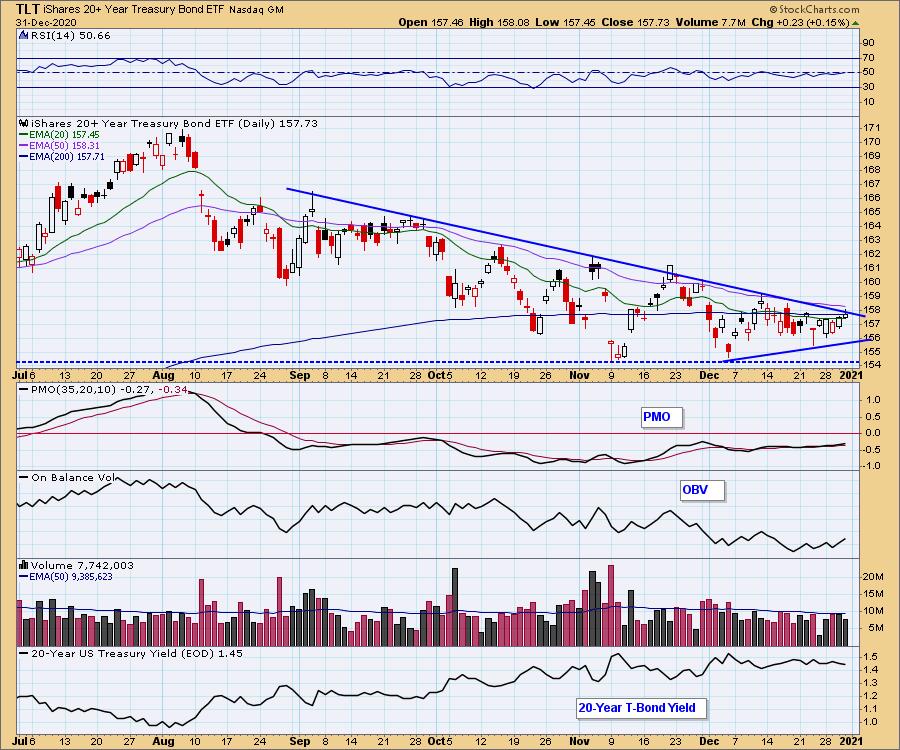
The RSI is neutral and despite a rising PMO, the one-year daily chart sports a bearish ascending triangle.
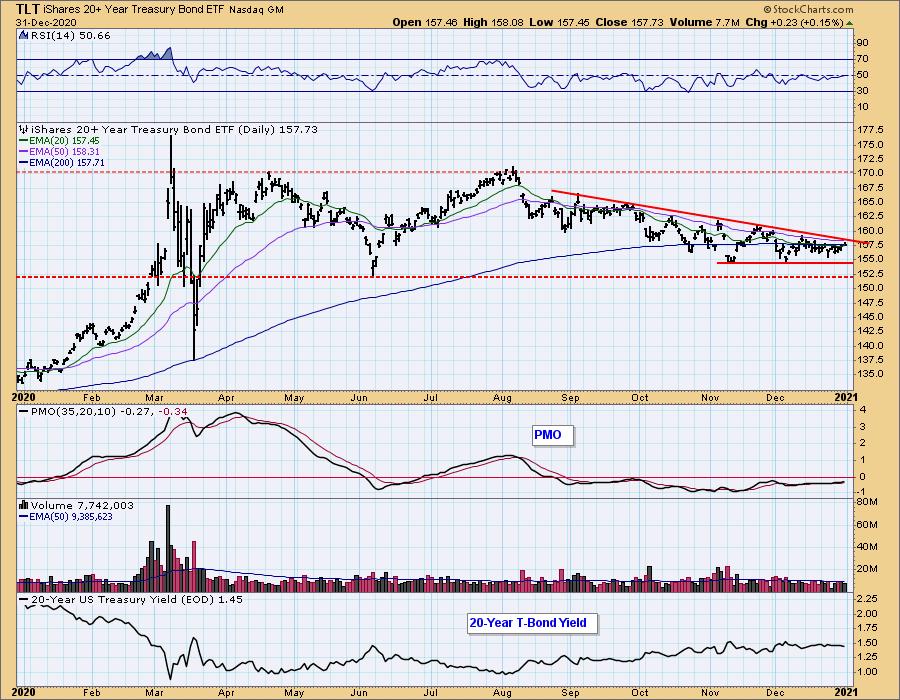
TLT Weekly Chart: The weekly PMO is falling, but in neutral territory. The RSI is negative but mostly neutral. Neutrality suggests more sideways consolidation.
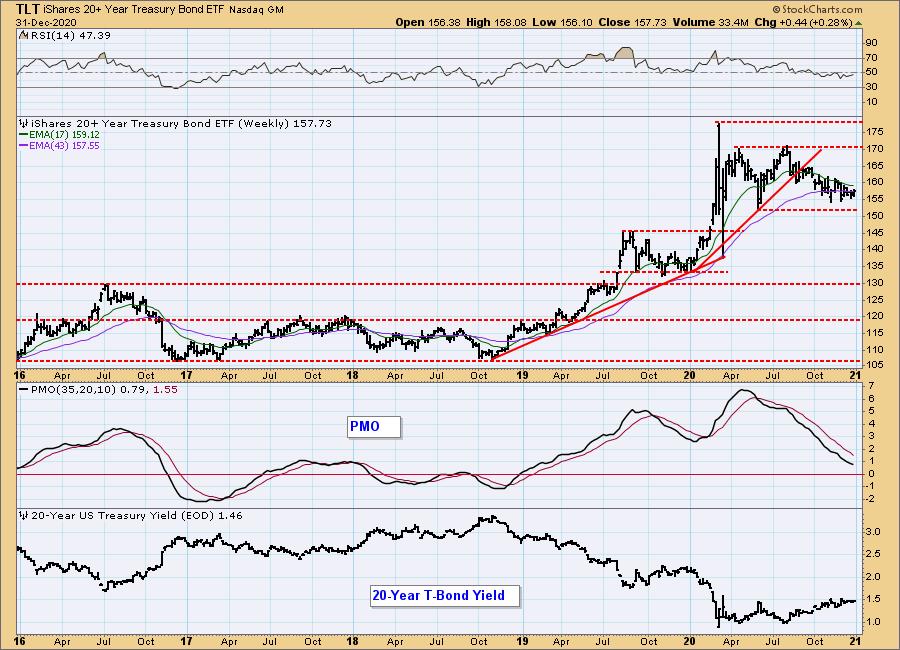
TLT Monthly Chart: The monthly PMO has topped in overbought territory as the parabolic rise was broken. Overall TLT has a neutral to bearish bias.
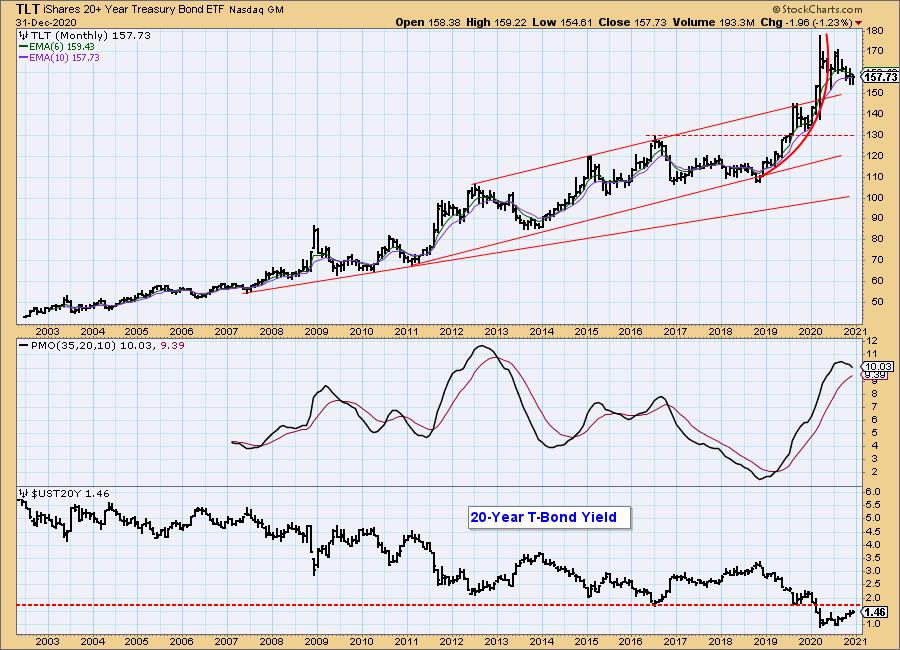
Technical Analysis is a windsock, not a crystal ball.
-- Carl & Erin Swenlin
___________
Our job is not to see the future, it is to see the present very clearly.
-- Jawad Mian, stray-reflections.com
Disclaimer: This blog is for educational purposes only and should not be construed as financial advice. The ideas and strategies should never be used without first assessing your own personal and financial situation, or without consulting a financial professional. Any opinions expressed herein are solely those of the author, and do not in any way represent the views or opinions of any other person or entity.
NOTE: The signal status reported herein is based upon mechanical trading model signals, specifically, the DecisionPoint Trend Model. They define the implied bias of the price index based upon moving average relationships, but they do not necessarily call for a specific action. They are information flags that should prompt chart review. Further, they do not call for continuous buying or selling during the life of the signal. For example, a BUY signal will probably (but not necessarily) return the best results if action is taken soon after the signal is generated. Additional opportunities for buying may be found as price zigzags higher, but the trader must look for optimum entry points. Conversely, exit points to preserve gains (or minimize losses) may be evident before the model mechanically closes the signal.
Helpful DecisionPoint Links:
DecisionPoint Alert Chart List
DecisionPoint Golden Cross/Silver Cross Index Chart List
DecisionPoint Sector Chart List
Price Momentum Oscillator (PMO)
Swenlin Trading Oscillators (STO-B and STO-V)
DecisionPoint is not a registered investment advisor. Investment and trading decisions are solely your responsibility. DecisionPoint newsletters, blogs or website materials should NOT be interpreted as a recommendation or solicitation to buy or sell any security or to take any specific action.
